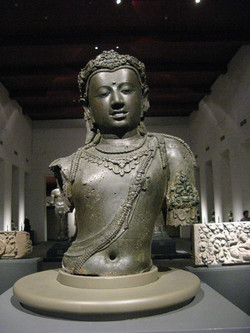Artwork Search
Arts in Southeast Asia Database
Avalokitesvara Bodhisattva
Keywords : Bangkok National Museum , Avalokitesvara , Bodhisattva
| Site common name | National Museum of Phra Nakhon |
|---|---|
| Type of artwork | Sculpture |
| Sub district | Phra Borom Maha Ratchawang |
| District | Khet Phra Nakhon |
| Province | Bangkok |
| Region | Central |
| Country | Thailand |
| Geographic Coordinates Decimal degree | Lat : 13.7576 Long : 100.492222 |
| Geographic Coordinates UTM | Zone : 47 P Hemisphere : N E : 661329.97 N : 1521418.09 |
| Place of artwork | In Bangkok National Museum exhibit room. |
| History of production | No written evidence of creation history was found. However, the art forms of the sculpture suggests its influences from Indian’s Pala Art and Central Java’s Art of Indonesia, both from 14th-15th Buddhist Century. Therefore, it is estimated that the sculpture is of the same period. |
|---|---|
| Production process | bronze casting |
| Art | The sculpture is in the damaged condition. Only the head and upper body in ‘Tribhanga’ posture (standing body position or stance used in the traditional Indian sculpture, art and Indian classical dance forms) are left. The lower part of body is lost. The face is plump and well-crafted. The eyelids are half closed. The Unalome is visible at the forehead while head wears the triangle crown with jewelries. The hair bun on the top of the head is broken and lost, only the hair that is down to the shoulders left. The body wears many accessories such as the leather body bracelet with the chamois head on the left shoulder. This body bracelet is overlapped by a pearl body bracelet. Two necklaces, the top one is of pearls and the lower one is jewelries with flowers decorated. The jewels bracelet is also visible. Overall, this sculpture reflects the relationship between the Network of Mahayana Buddhist Kingdoms such as Pala Dynasty of India and Shailendra Dynasty of Java. However, the study by Assoc Prof Chet Tingsanchali points out the traits of the sculpture that do not exist in Java Art which means this sculpture might be crafted in Thailand. |
| Key academic information | This Avalokitesvara Bodhisattva sculpture is praised as one of the most elegant artifacts of Srivijaya Art of Southern Thailand. It is the evidence of the close relationship between the Network of Mahayana Buddhist Kingdoms such as Pala Dynasty of India and Shailendra Dynasty of Java. According to the recent studies, it is likely that the artifact was crafted in Southern Thailand. |
| Notice | Some researchers believe that this sculpture is the same with the one mentioned in the Inscription of Wat Sema Mueang which reads that the King of Srivijaya ordered its creation in 775 A.D. However, Dr Chet suggests that the traits of sculpture bares similarity with the Art Style of 15th Buddhist Century while the scription belongs to 14th Buddhist Century, therefore it is unlikely to be the same one. |
| Period | Historical Period |
| Art period | Srivijaya |
| Age | 14th-15th Buddhist Century |
| Religion | Buddhism |
| Sect | Mahayana |
| Religion and belief | Mahayana Buddhism |
| Related artwork | The 8-arm Avalokitesvara Bodhisattva of Wat Phra BaromWat Phra Borommathat Chaiya, Chaiya District, Surat Thani, currently on display at Bangkok National Museum. |
| Type of License | Attribution-NonCommercial-NoDerivs (CC BY-NC-ND) |
|---|---|
| Rights | Princess Maha Chakri Sirindhorn Anthropology Centre |
| Date of record creation | 2016-09-30 |
| Record creator | Rungroj Thamrungraeng |
| Bibliography | Chet Tingsanchali. Thai Art under the inspiration of Pala’s Indian Art. Bangkok : Matichon, 2015. Piriya Krairuek. Art History of Thailand: Student Handbook Edition. Bangkok : Amarin Printing, 1985. Piriya Krairuek. Southern Art before 19th Buddhist Century. Bangkok : Fine Arts Department, 1980. |


